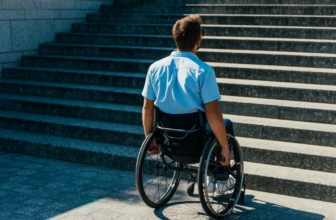If you have a disability and you're thinking of moving to a different state, here are five key things to consider before you rent that U-Haul.
When you have a physical disability, moving to another state or part of the country is complicated. There are so many reasons why we can’t just pick up and move to another place that able-bodied people don’t think about, and so many things we have to consider when we do have a possibility of moving. And yet, our lives as people with disabilities are often fundamentally shaped by where we live.
Moving can bring us closer to loved ones and give us access to better disability services and supports — but it can also do the opposite. As a wheelchair user who has moved eight times to and within four different states, here are five factors to consider before moving to a different U.S. state and/or region when you have a disability.
1. How will moving to a new state affect my Medicaid, health care, and/or home and community-based services?
Many people with physical and/or developmental disabilities receive home and community-based services (HCBS) through Medicaid, such as in-home care, respite, day programs, group home placement, job training, and funding for home modifications. Most of these services are only available through Medicaid — they are not covered by private insurance or Medicare (federal insurance).
Medicaid is a state program that provides health care to people who are low-income and/or disabled. Medicaid exists in every state, but it’s different in every state, often drastically different. Some states even call it something different, such as Medi-Cal in California. Medicaid does not transfer from state to state. If you move to another state, you have to apply for Medicaid in that state, and will inevitably experience a gap in services. So if you need in-home care, you’ll have to pay out-of-pocket for the months it will take to establish services in a new state.
Getting Medicaid disability-related services, or services of the quality you had in a different state, is not guaranteed. States are required by the federal government to offer Medicaid, but they have a lot of choices about the home and community-based services they offer and how many people are eligible for those services. Each state has its own Medicaid waivers with different rules and limitations. This means you could qualify for in-home care in one state but not another — or you might qualify, but the new state has limited funding set aside for home care, and you’ll be put on a years-long waiting list.
I run a Facebook group for discussing Medicaid home care waivers and have had many people join seeking help when they moved to another state and found themselves or a loved one unable to get services they previously received. Although the “best” and “worst” states depend somewhat on the type of services you need, you should be aware that the currently-popular destinations Texas and Florida both have decade-plus waiting lists for home care and developmental disability waivers. If you need Medicaid HCBS, please do lots of research before you move. Join online communities and talk to people with disabilities/family members who live in the state and find out what services are like there.
Some people choose to move to a different state specifically for access to better Medicaid HCBS. If you or a loved one has been stuck on a waiting list for years or can’t get adequate services where you are, moving may be the only solution.
2. Will I have access to quality health care and medication in the city/state where I want to move?
Moving to a new city or state often means changing health insurance, too. It’s essential to check before changing plans to make sure your doctors and prescriptions will be covered.
If you currently have health care under a Medicaid expansion program, or think you or a loved one might need Medicaid in the future, be aware that not all states have expanded Medicaid. You can see an updated list with a map here. Although not all states with expanded Medicaid have excellent disability services, the reverse is generally true — the states with the longest waiting lists and least-funded programs are the non-expansion states.
If you live with a rare or complex medical condition, access to specialists is critical. Connect online with others who have the same condition as you to see which doctors they recommend in the new city/state. Be sure to call those doctors before you move to make sure they are accepting new patients and that they take your insurance.
3. Will I be able to find disability-accessible housing in a new city if I move?
Housing is often the most critical and limiting factor for people with disabilities who want to move to another city or state. There is a nationwide shortage of affordable, accessible housing — but that doesn’t mean moving is impossible. You just need to plan carefully.
If you need affordable housing, a Section 8 Housing Choice Voucher can enable you to rent from a landlord — including a family member, if you have a disability. There is typically a waiting list for vouchers, but it can range from weeks to decades depending on the area. If you need a voucher, find out if the waiting list in the new area is open, and how long people typically wait to receive a voucher. You may even want to consider moving to an area with a short waiting list rather than waiting 5+ years for a voucher in a big city. Once you receive a voucher, you must live in that jurisdiction for one year — but after that, you can port your voucher anywhere else in the country. See this guide for more information.
Whether you’ll be renting or buying, make a list of everything you require for housing to be accessible to you. This will be different for each person. Do you need to live close to public transportation, or do you prefer a quiet rural or suburban area without bright city lights and noise? Do you need a yard for a service dog, or a condo or apartment with no yard to maintain? Do you need a roll-in shower or an adapted kitchen?
If you have a mobility disability and are planning to buy a home, research the common styles of residential architecture in the area to see whether they lend themselves to accessibility. For example, in California, many houses are single-story with just a step or two, and have fairly open floor plans. These houses could be made wheelchair-accessible fairly easily. However, in the Midwest, multi-story homes are popular; these are difficult and costly to remodel for accessibility. Often, styles vary by neighborhood as well, so once you determine which parts of town have the housing type you need, you can narrow your search.
For more resources, check out The Ability Toolbox Guide to Wheelchair Accessible Housing.
4. Will I need extra assistance to move, and how much will it cost?
Living on a fixed budget can be a challenge when planning a move to a new city, and it’s important to consider the value of your time and energy. You may need extra help with tasks such as organizing your possessions, packing boxes, and transporting everything to your new home. Whether you need help packing, dismantling furniture, or simply want to calculate moving costs accurately, it’s a good idea to set aside a portion of your budget for help moving.
Before you move, take some time to sell or donate anything you don't need, as the less stuff you need to bring with you, the cheaper using a moving service will be. Go through your old medical equipment and donate it to a program that provides free mobility aids to those in need or give it to a friend.
5. How accessible and inclusive are schools and universities in the area?
If you have a child with a disability, you want the best educational opportunities for them — which often means inclusion in classrooms with their typical peers. Although IDEA requires that children with disabilities be educated in the least restrictive environment, in practice, many kids are segregated and many parents must fight for their right to inclusion. In some areas, these battles have been won and lasting change has been at least somewhat achieved, while in others, there’s still a long way to go.
Before you move, do some research on the school districts and neighborhood schools. The usual measurements for good schools may be less relevant in your situation, so find parents of kids with disabilities who live in the area to get their recommendations. Then narrow down your home search to neighborhoods in those districts.
If you or your child may pursue higher education in the future, look into accessibility at local colleges and universities. Is the campus wheelchair accessible? Do they offer online classes? Do they have a robust program to provide support to students with learning and/or physical disabilities? Although some young adults with disabilities do move away for college, it’s nice to have a local option.
6. How will the weather and future effects of climate change affect disability accessibility and my health?
If you’re not sure of the best place to move for your disability, or you’re trying to choose between a couple of options, the weather could be a deciding factor.
Weather can have a direct impact on our health, reducing or exacerbating symptoms. For example, many people with arthritis and other chronic pain conditions find that they have more mobility and less pain living in a dry, warm climate such as Southern California, Arizona, or New Mexico. Cold tends to increase pain, but barometric pressure changes in hot, humid climates such as the U.S. South can also contribute to chronic illness flare-ups, and sun protection clothing may be needed.
Weather can also affect the accessibility of our environment. If you live in an area with heavy snowfall, it may be difficult to leave your home in the winter — or for family or caregivers to get to you if you need help. Some cities and towns do a better or worse job shoveling sidewalks; be sure to look into this before moving if you use a wheelchair or other mobility aid and need to get around without a car during the winter.
Every place in the U.S. is prone to natural disasters of some kind, so it’s important to know the hazards in a new area before you move. Often, there are ways to minimize or reduce your risk. When looking at a home to buy or rent, check to see if it is in a hurricane, flood, or fire zone. You may want to live near the beach in Florida, but considering the time and cost of finding and/or remodeling a home for accessibility, choosing an apartment or house several miles inland is a safer option.
Develop a safety plan in case you need to evacuate or shelter in place due to a natural disaster. If you can’t drive, who will help you leave? Do you have non-perishable food on hand and a backup battery to charge or power your essential medical equipment? If you are unable to prepare or protect yourself in the event of a disaster that is common in an area, you may want to consider a different place to live.
And finally, consider the potential impact of climate change. Hurricanes and thunderstorms are becoming more severe as temperatures increase, and scientists predict that sea levels will rise, flooding many coastal areas. This may sound like a far-off nightmare, but it could happen within the lifetimes of many young and middle-aged people with disabilities. Previous disasters such as Hurricane Katrina have demonstrated that people with disabilities and seniors are often forgotten, neglected, and left behind in a crisis. We have to think about the future because the future won’t think about us.
Resources for Moving With a Disability
- How to Get On — a self-advocacy guide for getting the disability services you need
- How to Find Accessible Housing
- How to Make Your Home Accessible on a Budget
- Medicaid Consumer-Directed Home Care Waivers State by State Guide
- Medicaid Waiver Waiting List State by State Chart
- Status of State Medicaid Expansion Decisions: Interactive Map
- How to Port Your Section 8 Voucher
- Partnership for Inclusive Disaster Strategies — organization advocating for better emergency services for people with disabilities
As someone with a disability who has moved several times, I know that there is no perfect place to live, no fully-accessible and affordable disability paradise. But if we set priorities and work steadily towards our goals, we can improve the quality of our lives by moving to a place that better meets our needs.
Image via Deposit Photos
Founder and Editor-in-Chief of The Ability Toolbox. I received my BA in English from Stanford University and MA in Clinical Psychology from Antioch University Los Angeles, and have worked in entertainment and health media for over 20 years. I also blog about traveling with a disability. As a wheelchair user with cerebral palsy, I am deeply committed to amplifying the voices of the disability community through writing and advocacy.







